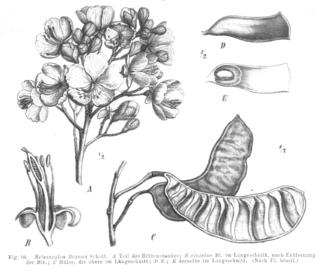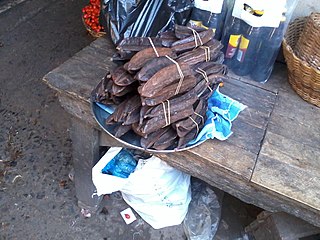
The Mimosoideae are a traditional subfamily of trees, herbs, lianas, and shrubs in the pea family (Fabaceae) that mostly grow in tropical and subtropical climates. They are typically characterized by having radially symmetric flowers, with petals that are twice divided (valvate) in bud and with numerous showy, prominent stamens.

The Fabaceae or Leguminosae, commonly known as the legume, pea, or bean family, are a large and agriculturally important family of flowering plants. It includes trees, shrubs, and perennial or annual herbaceous plants, which are easily recognized by their fruit (legume) and their compound, stipulate leaves. The family is widely distributed, and is the third-largest land plant family in number of species, behind only the Orchidaceae and Asteraceae, with about 765 genera and nearly 20,000 known species.

Delonix is a genus of flowering plants in the family Fabaceae, subfamily Caesalpinioideae. It contains trees that are native to Madagascar and East Africa. By far the best known species is the Royal Poinciana.

Melanoxylum is genus of plants in the legume family, Fabaceae. It includes a single species, Melanoxylum brauna, the yellow-flowered brauna tree. It is native to eastern Brazil. The genus is part of subfamily Caesalpinioideae.
Stuhlmannia moavi is a species of flowering plants in the legume family, Fabaceae. It is the only species in the genus Stuhlmannia. It is a tree native to Kenya, Tanzania, and Madagascar, where it grows in seasonally-dry tropical forest, woodland on limestone, and in riverine forest. The genus belongs to tribe Caesalpinieae in subfamily Caesalpinioideae.

Koompassia is a genus of legume in the family Fabaceae. It includes three species with range across southeast Asia, from Thailand to New Guinea. It belongs to the subfamily Dialioideae. They are tall tropical rainforest trees; K. excelsa is one of the tallest tree species in the tropics.
Sympetalandra is a genus of legume in the family Fabaceae. It includes five species of trees native to Malesia (Peninsular Malaysia, Sumatra, Borneo, the Lesser Sunda Islands, and the Philippines, where they grow in lowland tropical forest. It belongs subfamily Caesalpinioideae.
Vouacapoua is a genus of legume in the family Fabaceae, subfamily Caesalpinioideae. It includes three species of trees native to northern South America, ranging from the Guianas to northern and northeastern Brazil. They grow in terre firme Amazonian rain forest.

Newtonia is a genus of flowering plants in the legume family, Fabaceae. It includes 16 species of trees native to sub-Saharan Africa. It belongs to subfamily Caesalpinioideae and the Mimosoid clade or tribe. The genus is known from the early Miocene of Ethiopia based on compressions of its diagnostic, winged seeds.

Cercidoideae is a subfamily in the pea family, Fabaceae. Well-known members include Cercis (redbuds), including species widely cultivated as ornamental trees in the United States and Europe, Bauhinia, widely cultivated as an ornamental tree in tropical Asia, and Tylosema, a semi-woody genus of Africa. The subfamily occupies a basal position within the Fabaceae and is supported as monophyletic in many molecular phylogenies. At the 6th International Legume Conference, the Legume Phylogeny Working Group proposed elevating the tribe Cercidae to the level of subfamily within the Leguminosae (Fabaceae). The consensus agreed to the change, which was fully implemented in 2017. It has the following clade-based definition:
The most inclusive crown clade containing Cercis canadensisL. and Bauhinia divaricataL. but not Poeppigia proceraC.Presl, Duparquetia orchidaceaBaill., or Bobgunnia fistuloides(Harms) J.H.Kirkbr. & Wiersema.
Lophocarpinia aculeatifolia is a species of flowering plants in the legume family, Fabaceae. It is the sole species in genus Lophocarpinia. It is a tree native to Paraguay and northern Argentina. It belongs to tribe Caesalpinieae of subfamily Caesalpinioideae.

Recordoxylon is a genus of flowering plants in the legume family, Fabaceae. It includes three species of trees native to the tropical Amazon rainforest of northern South America, and the species' range includes northern Brazil, Colombia, French Guiana, Guyana, and Venezuela. Habitats include non-flooded rain forest on terra firme, seasonally-flooded riverine forest (várzea), and montane forest.

Piliostigma is a genus of flowering plants in the legume family, Fabaceae. It includes five species of small deciduous trees native to sub-Saharan Africa, the Indian subcontinent, Indochina, Java, the Philippines, and northern Australia. It belongs to the subfamily Cercidoideae and the tribe Bauhinieae. It is dioecious, with male and female flowers on separate plants.

Falcataria is a genus of flowering plants in the family Fabaceae. It belongs to the monophyletic Mimosoid clade in the subfamily Caesalpinioideae. The genus has three species previously classified in the Falcataria section of the genus Paraserianthes by I.C. Neilsen. The distribution of these closely related species within the genus Falcataria links the wet tropics of north-east Australia to New Guinea, the Moluccas, Bismarck Archipelago, and the Solomon Islands east of Wallace's line similar to other plant taxa from the region.

Amblygonocarpus is a genus of flowering plants in the legume family, Fabaceae. It contains a single species, Amblygonocarpus andongensis, a tree is native to sub-Saharan Africa. The genus belongs to the mimosoid clade of the subfamily Caesalpinioideae.
Lemurodendron is a genus of flowering plants in the legume family, Fabaceae. It contains a single species, Lemurodendron capuronii, a tree endemic to Madagascar. It belongs to the mimosoid clade in the subfamily Caesalpinioideae.
Piptadeniopsis lomentifera is a species of flowering plant in the legume family, Fabaceae. It is a tree native to southwestern Bolivia and Paraguay. It is the sole species in genus Piptadeniopsis. It belongs to the mimosoid clade of the subfamily Caesalpinioideae.

Tetrapleura is a genus of flowering plants in the mimosoid clade of the family Fabaceae. It includes two species of trees native to sub-Saharan Africa, ranging from Senegal to Kenya and Tanzania, and south to Angola. They grow in tropical lowland rain forest, secondary thicket, and fringing forest in the Guineo-Congolian forest and Lake Victoria basin.
Prosopis humilis, the algarrobilla or algaroba, is a mesquite, a flowering plant and a tree species in the genus Prosopis found in Argentina.
Uittienia modesta is a species of flowering plant in the legume family, Fabaceae. It is a tree native to Borneo and Sumatra. It is the sole species in genus Uittienia, which belongs to subfamily Dialioideae.












